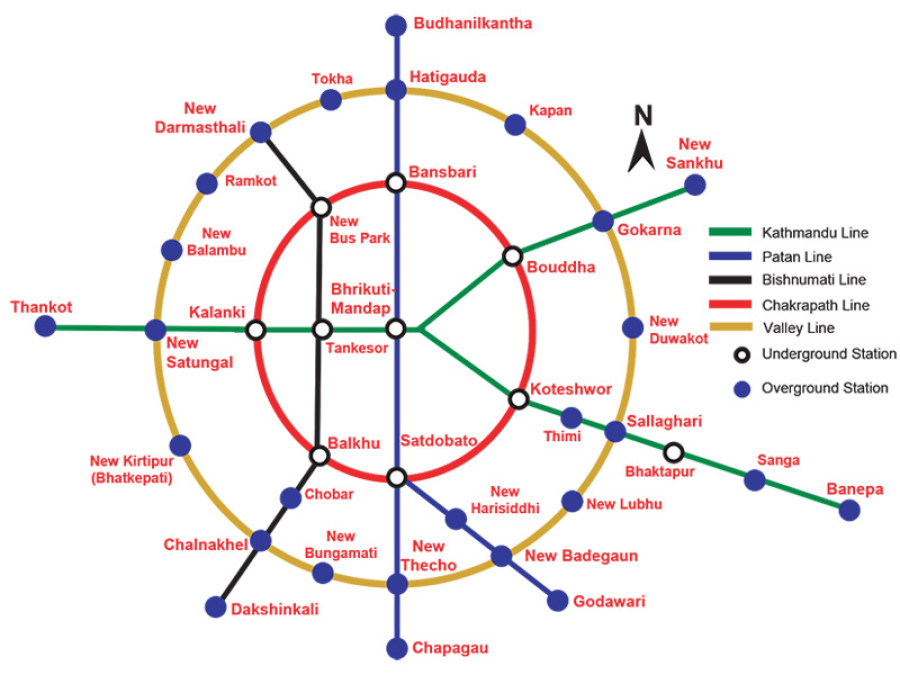Opinion
Trains wanted
An integrated transport system is crucial for the regeneration of Kathmandu
Binod L Amatya
Kathmandu, the Capital and economic hub of Nepal, is in danger of becoming stagnant due to a poor transport infrastructure. Life is a daily struggle in the Capital for commuters. The existing transport network is fragmented, and connectivity between the old and new settlements in the Kathmandu Valley barely exists.
The Great Earthquake devastated many old and new settlements of the Valley. Many suburban areas remained cut off preventing timely rescue during the disaster. This highlights the lack of crucial transport connections. The Valley is in a need of a comprehensive urban design, infrastructure planning and development, not just rehabilitation and reconstruction for the post-disaster rebuilding. In order to make the Capital connected, organised and vibrant for the 21st century, a radical change in its transportation infrastructure is essential. Such change will only be possible through the development of a modern urban railway network within the Valley.
Proposed railway plans
A new mode of transport, the railway, is central to the regeneration of the city. The proposed bus rapid transit will not solve the transport problems in the long term. In this article, I propose the concept of cross-rail for an urban rail network to service the city and suburban areas in the Valley. It comprises the establishment of railway routes crossing the city which can connect the suburban areas. Two lines, the Kathmandu Line which runs east to west and the Patan Line which runs north to south, could connect the city.
The core city area located within the Ring Road is the Central Activity Zone (CAZ) of the Capital and a Prime Opportunity Area (POA). This area is in need of better connectivity with other growing Opportunity Areas (OAs) around the Valley. Thus, the proposed two lines will pass through the CAZ and connect suburban areas such as Budhanilkantha in the north, Chapagaun and Godavari in the south, Thankot in the west and Sankhu and Banepa in the east. These two lines will be a combination of underground and over-ground railway systems.
The proposed Bishnumati Line will facilitate further connectivity. This line also passes through the CAZ and connects suburban areas such as Dharmasthali in the north and Dakshinkali in the south. A circular line named Chakrapath Line, which basically follows the current alignment of the Ring Road, will further facilitate the CAZ.
The line could be built underground or overground.
An urban rail network is not just a transportation facility; it is also an instrument to restructure the city. In this regard, satellite towns can be built by extending the rail network to many suburban areas and developing a railway station at the heart of the new settlements. An outer circle line named Valley Line could connect Bungamati, Thecho, Badegaun, Lubhu, Gokarna, Kapan, Tokha, Ramkot, Balambu, Satungal and Bhatkepati.
Centre and periphery
With the introduction of a modern transport system, it is essential to preserve the uniqueness of the historic old settlements in the suburban areas. In this regard, the old settlements need to be rehabilitated. But in the meantime, they can be regenerated by developing a sister town in the vicinity, and such towns will be connected with the railway network. The railway stations could be located on the outskirts of the old settlements in New Bungamati, New Thecho, New Badegaun, New Lubhu and New Kirtipur. Currently, no orbital road exists in these suburban areas, and interconnectivity is very poor. This will change with the introduction of the Valley Line. This line can be built as an at-surface track and for this, an approximately 24-metre wide corridor should be acquired to lay the railway track.
Kathmandu will inevitably continue to grow. Many opportunity areas have already evolved in many parts of the Valley in recent years. As the city has a great potential to be an important economic hub for Sino-Indian trade, certain parts of the Valley outside the CAZ should be developed as business hubs. Chobhar, Ramkot (Sitapaila) and Banepa could be the prospective business hubs of Kathmandu. The first two locations are promising due to favourable ground conditions and proximity with the opportunity area, while the third location is already an established business transit to the northern border.
Need for action
A phased development plan would be an appropriate way to achieve this bold mission. For this, a pilot scheme should be initiated to test our ability to deliver modern infrastructure and monitor performance. A section of the Kathmandu Line connecting Bhrikuti Mandap and Banepa or Sankhu and a section of the Valley Line connecting New Bungamati and Gokarna could be constructed as pilot schemes to be completed in the next five years. A broader vision should also be adopted by finding ways to integrate the Kathmandu rail network with the proposed national East-West Railway network. Kathmandu could be completely transformed if we aim to complete this plan within the next 20 years.
In conclusion, a comprehensive integrated transport system is crucial for the regeneration and economic growth of the city. We must embrace a much bolder vision. Our plan should foresee the future and plan for the next 20 to 50 years. Until now, there has been a glaring absence of vision, action and investment for our national infrastructure. If this persists, the Capital will remain chaotic and disintegrated. The country is in need of a new resilient Kathmandu. Kathmandu is the engine of the country. A new Kathmandu will help to transform the whole country. Thus, the development of a railway infrastructure is a timely need for the Capital.
Amatya is a consulting civil engineer currently based in the UK




 13.12°C Kathmandu
13.12°C Kathmandu










%20(1).jpg&w=300&height=200)

